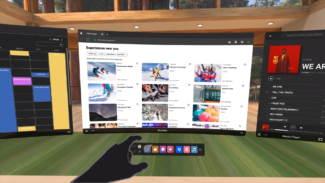Meta’s Project Cambria headset could have 12 GB RAM for multitasking, import logs and a potential leak suggest.
Project Cambria was announced in late October at Connect 2021. Cambria isn’t Quest 3 – Mark Zuckerberg described it as an “advanced and high end product” positioned “at the higher end of the price spectrum” to be sold alongside Quest 2. At one point it was called ‘Quest Pro’ internally.
Cambria appears to have a more balanced design than Quest 2, with a smaller frontbox and a strap resembling Quest 2’s elite strap accessory. Meta says this is achieved through the use of pancake lenses instead of fresnel lenses. Whereas Quest 2 has grainy black & white cameras, Cambria will have high resolution color passthrough for mixed reality experiences. It will also include eye tracking and face tracking to drive avatars in social VR.
During Meta’s Q1 2022 earnings call yesterday Zuckerberg told investors Cambria will be “more focused on work use cases” than Quest 2, saying he sees it “eventually replacing your laptop”. Meta has been slowly adding productivity features to its VR operating system, branded as Infinite Office. If you have a Logitech K830 or Apple Magic Keyboard, they’ll show up in VR so you can type and use the trackpad to navigate. Triple window support was added to the web browser in August, with window resizing added in December.
Quest 2 handles triple windows fine most of the time, but the browser is only accessible in the home environment. If you want to look something up while still inside a VR app you need to close it first. This limitation may be down to the device having just 6 GB of RAM.
Import logs found by SadlyItsBradley, Reggy04, and Samulia reference a shipment sent to Meta in March of “SEACLIFFBCM” with “256GB / 12GB” in the description – Seacliff being the codename for the Project Cambria headset. Given Quest 2 is sold in 128 GB and 256 GB models that’s almost certainly the storage size, with 12 GB being the amount of RAM.
SadlyItsBradley (Brad Lynch) also says he has a source claiming the Quest OS will be “heavily optimized and separated into many independent systems” to enable 3 key features:
- Suspending 2D and VR applications so you can launch another app and resume your progress “seamlessly” later
- Anchoring windows to different areas of your Home space, with the other areas suspended
- System Windows API (beta), letting developers put system dashboard windows (including the browser) in their applications.
It could be argued that Cambria’s extra RAM might be to handle the eye tracking, face tracking, and color passthrough – Pico Neo 3 Pro Eye has 2GB extra RAM. But it seems unlikely an entire 6 GB would be needed for these functions. Given 12 GB of RAM, Zuckerberg’s comments about work use cases, and Brad’s source; Cambria’s hardware may be much more capable of multitasking than Quest 2.







